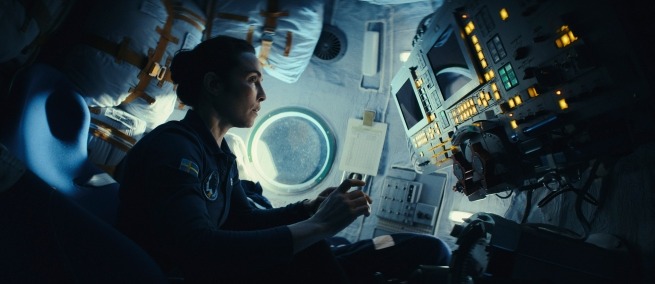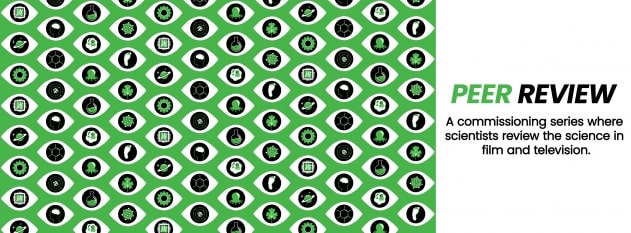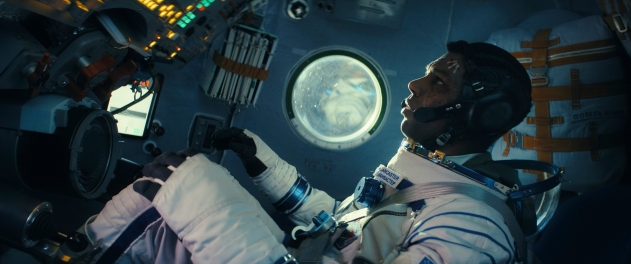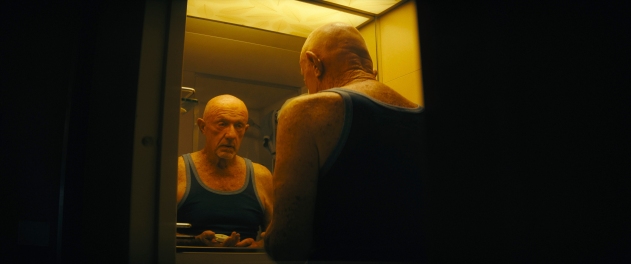

“Quantum mechanics is weird!” is likely the most uttered sentence in the halls of physics departments since the early 1900s. CONSTELLATION, the new series airing on Apple TV+ written by Peter Harness, brings this light-hearted remark on the non-intuitive nature of a scientific theory to its most terrifying implications. The show plays as a thriller bordering on horror, building up tension and setting up ever-imminent jump-scares. But these never happen: what is ghastly is not an evil presence lurking in the shadows, but rather the very nature of our world. Nonetheless, watching the series requires a good dose of scientific suspension of disbelief, as the writing plays fast and loose with some of the quantum physics it portrays.
The show starts with a bang. European Space Agency (ESA) astronaut Jo Ericsson (Noomi Rapace) is dealing with the aftermath of a fatal accident aboard the International Space Station (ISS), which seemingly happens at the exact moment the Cold Atom Laboratory (CAL, a fictionalized version of a Jet Propulsion Laboratory experiment) is turned on. As Jo fends for her life on the ISS, she starts to have terrifying visions involving hallways, wardrobes, and her fellow astronaut Paul Lancaster (William Catlett), who did not survive the accident. After she returns to Earth, against all odds—with Paul’s body and the CAL—her sense of alienation from reality worsens. Was her car red or blue? Could she play the piano? Was she estranged from her husband, Magnus (James D'Arcy)? Why does her daughter, Alice (twins Rosie and Davina Coleman), seem like a different person? Roscosmos and ESA directors, Irina Lysenko (Barbara Sukowa) and Fredric Duverger (Julian Looman) have a simple answer: some astronauts experience “burnout” upon their return home, and medical treatment is necessary. Jo does not accept that her feelings and visions are only a mental health crisis. Her resolve to validate her intuition and her longing to be reunited with her real child are the main drivers of a complex plot, developing in a non-linear fashion both in time and across different possible realities.

The scientific hinge of the narrative is the concept of quantum superposition. In quantum physics, particles may only be allowed to occupy certain discrete states–for instance, an electron orbiting the nucleus of an atom may do so only in specific ways. This is a direct consequence of the wave nature of matter and is not in itself particularly troubling; it is the same effect that constrains piano strings to play the one note to which they are tuned when they are struck. What makes quantum mechanics special is that particles can be prepared in a superposition of these discrete states, which means they can occupy multiple of them simultaneously. When this happens, an electron will be here and there at the same time, Schrodinger's cat will be both dead and alive, and the world will nonchalantly proceed in its endeavors as if all of these possibilities were true. That is, until an observer for whom the world cannot be in a superposition state (for example, a human being) decides to check what is going on. When such an observer performs a measurement, all possibilities collapse into a single state, and only then will the electron have to pick whether it is here or there, or will the cat know whether it is dead or alive. These effects are extremely counterintuitive and spooked the likes of Einstein himself.
The existence of two parallel, superimposed storylines is the main driver of the story in CONSTELLATION. As the episodes progress, viewers realize that the initial tale we have been shown is only one of two different ways in which the events are unfolding. Elsewhere, it was Jo who perished in space, and Paul the one who returned to his family. In one reality Irina is the head of Roscosmos, in the other she died in space and her body (the Valya), forever enshrined in her orbiting cosmonaut suit, caused the present-day accident. This duality is everywhere, with some characters being more aware of it than others. Alice shares Jo’s intuitive perception that they are not quite mother and daughter and will eventually manage to hold deeply moving conversations with her alter-ego, realizing that space travel has exchanged their mothers. Henry/Bud Caldera (Jonathan Banks) is the person whose understanding of these intricacies is most developed: in the reality where Jo is alive, Henry is the Nobel laureate from the Rocket Propulsion Laboratory (where “Rocket” is substituted for “Jet” for mysterious reasons to me) who built the CAL with ulterior personal purposes beyond pure scientific curiosity. We slowly come to realize that the astronaut-turned-physicist needs the machine to deal with the aftermath of his own body-swap experience after a tragic mission in space shared with an evil counterpart, Bud.

Once CONSTELLATION is viewed as an exercise in bringing the concept of superposition to its extreme, some of its storytelling becomes tantalizing. Its finale feels like a missed opportunity. The key to the first seven episodes is not that there exist two realities in which different things happened. Both of the scenarios that the series is portraying are indeed taking place, it is simply that no measurement has been made to decide which one is to be picked. This can be deeply terrifying for those whose very survival depends on a specific outcome of the coin flip. In particular, Episode 7 works almost as a short film providing viewers with a captivating and distressing experience of what it would be like to live in a superimposed reality. The wink to Schrodinger’s cat drives the point home even for those viewers less acquainted with quantum physics. Alice, who like her namesake goes through the looking glass and experiences her own duality, seems to accept that this is just nature and makes peace with her mother’s fate. Caldera won’t stop until it is all over. Up to this point, the series’ science-driven plot is crafted effectively so that viewers share the characters’ sense of estrangement. I was longing for Jo, Paul, and Irina to make the brave choice to perform the measurement, to open their own Schrodinger’s box and force themselves to be found either dead or alive. Instead, CONSTELLATION shied away from itself, neatly separating realities once again, falling into tropes, and ending in a baffling final scene in which Jo’s dead body in space comes back to life. Despite certain inaccuracies in the science depicted, especially with regard to the CAL, the series managed to remain consistent within its fictionalized use of quantum mechanical suggestions. This internal coherence seems to be lost as the series wraps up.
On the topic of scientific inaccuracies, I need to make a final remark on the CAL and the phase of matter it produces, the Bose-Einstein condensate (BEC). Bose-Einstein condensates are a phase of matter that emerges at ultracold temperatures, when quantum mechanics becomes relevant, and the wave nature of particles becomes predominant. They are not directly related to quantum superposition. Moreover, unlike what Henry claims, they can be realized on Earth without a problem. The first one was observed in 1995 between the mountains of Colorado. In the following 30 years, their properties, including counterintuitive behaviors like superfluidity and matter-wave interference, have been studied in tremendous detail. The reason why the CAL was designed is not because microgravity is necessary for the realization of BECs, but rather because it can provide a unique environment to observe condensate geometries unattainable on Earth, reach colder temperatures, and study gravity itself. The CAL’s research program is fascinating, but it definitely falls short of creating superpositions of different realities. I will admit that the use of Bose-Einstein condensates and of the CAL in the series puzzles me, as they are quite misrepresented, and they do not seem to be necessary to the plot as I understood it. Reimagining science for narrative reasons is completely understandable, but some of the choices made in CONSTELLATION felt gratuitous and did not seem crucial to advancing the plot.
TOPICS